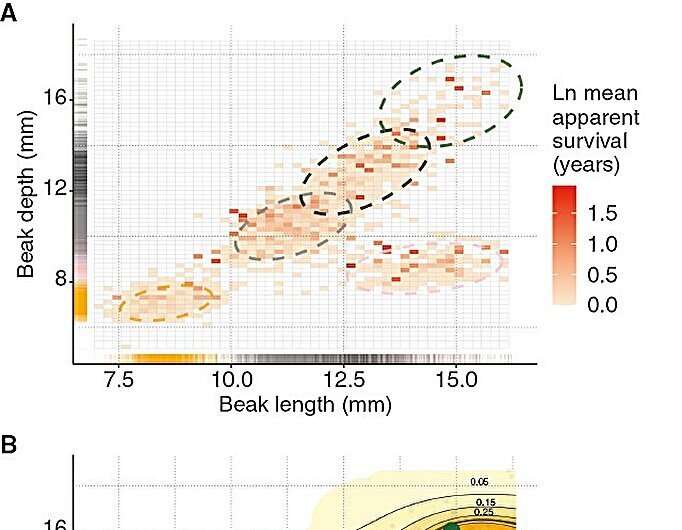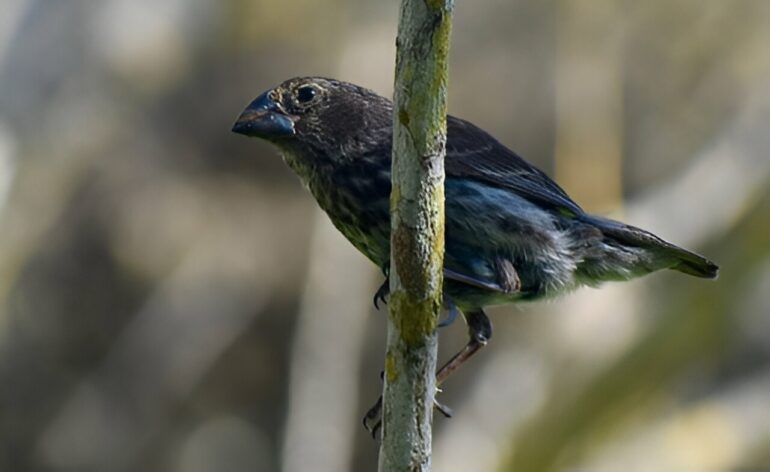Using data on four species of Darwin’s finches on the Galápagos Islands, researchers led by McGill University have confirmed a long-standing hypothesis that species diversity evolves through adaptation to different resources.
Evolutionary biologists have long suspected that the diversification of a single species into multiple descendent species—that is, an “adaptive radiation”—is the result of each species adapting to a different environment. Yet formal tests of this hypothesis have been elusive owing to the difficulty of firmly establishing the relationship between species traits and evolutionary “fitness” for a group of related species that recently diverged from a common ancestral species.
A global team of biologists led by McGill University has compiled nearly two decades of field data—representing the study of more than 3,400 Darwin’s finches in the Galápagos Islands—to identify the relationship between beak traits and the longevity of individual finches from four different species.
Recently selected as the Editor’s Choice article for the December issue of Evolution, the study used data from four species, which all evolved from a single common ancestor less than 1 million years ago. The researchers constructed a detailed “fitness landscape” to predict the likelihood of an individual’s longevity in relation to their beak traits.

Fitness and adaptive landscape of Geospiza spp. at El Garrapatero (Santa Cruz Island). (A) fitness Ln-transformed mean for bins of phenotypes without model by increments of 0.14 mm. The ellipses are 95% multivariate t-distributions based on the individual beak phenotypes of each species. (B) Individual-based fitness landscape from the spline model. Note that there are more contour lines compared to the legend to show the peaks more clearly. (C) the adaptive landscape is obtained by “moving” a simulated population for each phenotypic mean and mean predicted fitness. The fitness landscape spline model predicted the fitness values of the simulated population to generate the adaptive landscape (Schluter, 2000). The color scale is scaled to be comparable between the figures. The triangles are the local fitness peak maximum and the large points are the population phenotypic means for the various modes of ground finches (smaller transparent points are the data for each bird). Distances between fitness peaks (triangles) and population means (larger points) were calculated using Euclidean distances. © Evolution (2023). DOI: 10.1093/evolut/qpad160
They found that finches with the beak traits typical of each species lived the longest, whereas those that deviated from the typical traits had lower survival. In short, the traits of each species correspond to fitness peaks that can be likened to mountains on a topographic map separated from other mountains by valleys of lower fitness.
“Biological species are diverse in their shape and functions mainly because individual traits, such as beaks, are selected by the environment in which the species are found,” said lead author Marc-Olivier Beausoleil, a doctoral researcher at McGill University, supervised by Professor Rowan Barrett.
As a result, “the diversity of life is a product of the radiation of species to specialize on different environments; in the case of Darwin’s finches, those environments are different food types,” adds Professor Andrew Hendry, who has been a part of the project for more than 20 years.
Perhaps surprisingly, the researchers also found that the different species of finches studied have not reached the top of their fitness “mountain,” suggesting that each species is not perfectly adapted to their food type. Whether such “perfection” will ultimately evolve remains to be seen.
More information:
Marc-Olivier Beausoleil et al, The fitness landscape of a community of Darwin’s finches, Evolution (2023). DOI: 10.1093/evolut/qpad160
Citation:
Study of Darwin’s finches sheds light on how one species become many (2024, January 8)



